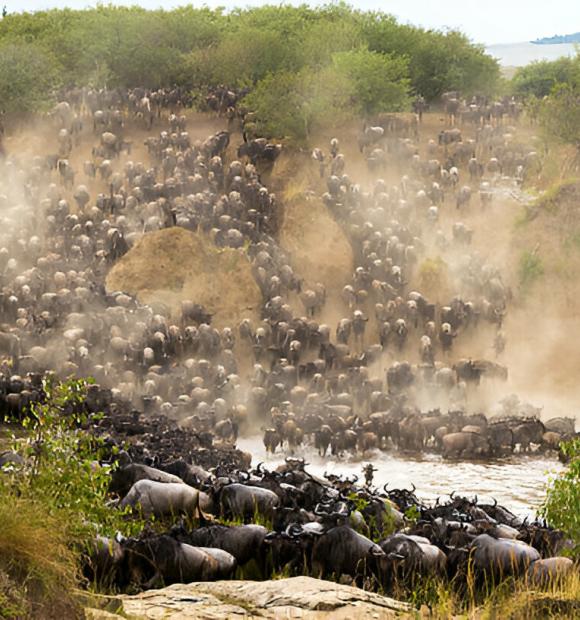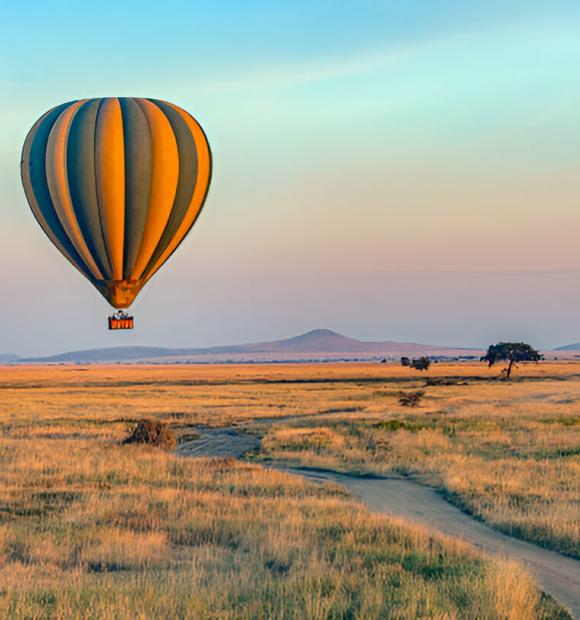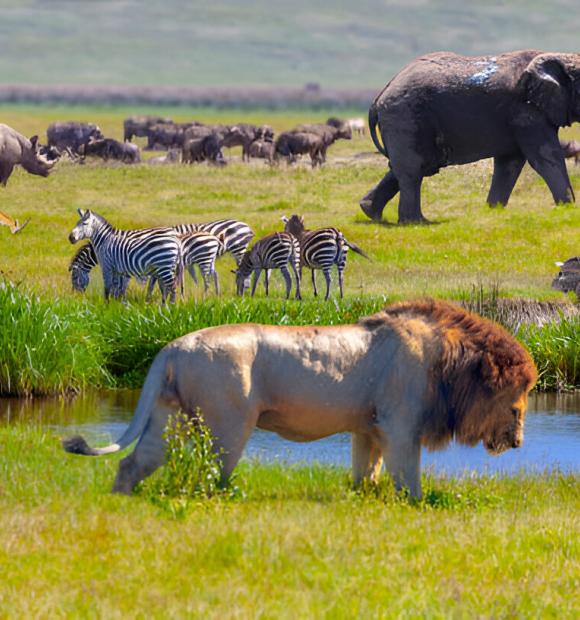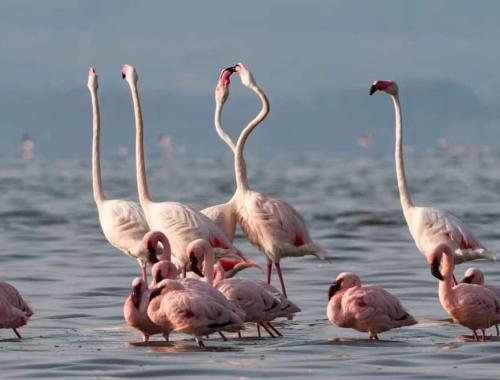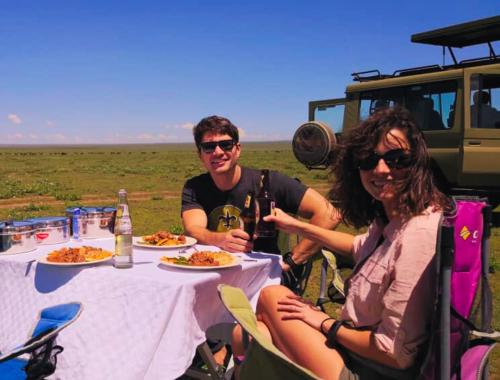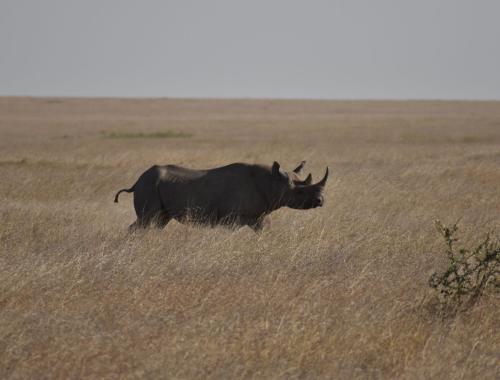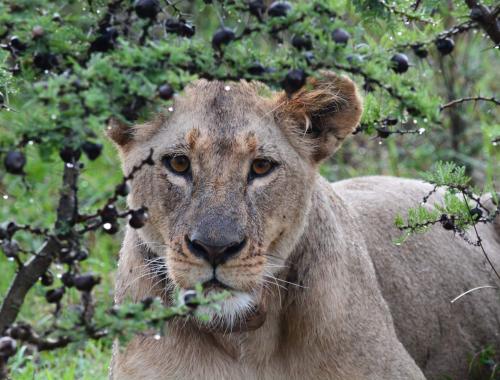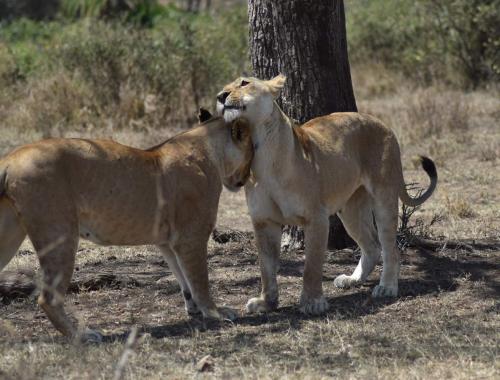Serengeti National Park
Serengeti is a large and famous wildlife park in northern Tanzania, East Africa. It is known for its wide, open grasslands and huge numbers of wild animals. The name "Serengeti" means "endless plains" because the land stretches very far without many trees. Every year, millions of animals like wildebeests, zebras, and gazelles travel across the Serengeti in a big journey called The Great Migration. They move to find fresh grass and water, and along the way, they are chased by predators like lions and crocodiles.
The Serengeti is also home to many other animals such as elephants, giraffes, cheetahs, hyenas, and hundreds of birds. People from all over the world visit the Serengeti to go on safari and see the animals in their natural home.
It is one of the best places on Earth to experience wildlife and nature!
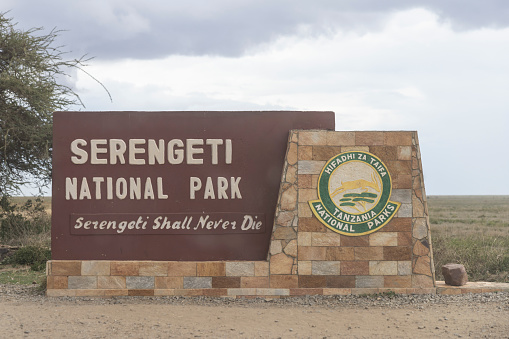
Quick Facts about the Serengeti 🌿🦁
📍 Location: Northern Tanzania, East Africa
🌍 Size: About 30,000 square kilometers (12,000 square miles)
🐾 Famous for: The Great Migration — millions of wildebeests, zebras, and gazelles
🦁 Wildlife: Home to the Big Five — lion, elephant, leopard, buffalo, and rhino
🦓 Other animals: Giraffes, cheetahs, hyenas, crocodiles, hippos, and 500+ bird species
🕰️ History: One of the oldest ecosystems on Earth
🛡️ Protection: UNESCO World Heritage Site
🎈 Activities: Safari drives, hot air balloon rides, camping, photography
🧩 Meaning of the name: "Serengeti" means "endless plains" in the Maasai language
History of the Serengeti
The Serengeti is a very old and natural area in northern Tanzania. For millions of years, it has been home to wild animals and early humans. Fossils found nearby, especially in Olduvai Gorge, show that some of the first humans lived in this region. The Maasai people, who are traditional cattle herders, have lived around the Serengeti for hundreds of years. They named the area "Siringet," which means "endless plains" in their language, because of the wide open grasslands. The Maasai respected nature and shared the land with wildlife.
In the late 1800s, European explorers discovered the Serengeti and were amazed by its beauty and huge numbers of animals. However, hunting soon became a problem, and animal numbers started to decrease. To protect the wildlife, the Serengeti was made a national park in 1951. This helped to stop hunting and keep the animals safe. Later, in 1981, the Serengeti became a UNESCO World Heritage Site, meaning it is protected as an important place for the whole world.
Today, the Serengeti is one of the most famous parks in Africa. It is known for its incredible wildlife, especially the Great Migration, and people work hard to keep it safe for future generations.
Accessing the Serengeti
Accessing the Serengeti can be done by air, road, or a combination of both, depending on your travel preferences.
-
By Air (Fastest Option): International Flights: Start by flying into Kilimanjaro International Airport (JRO) or Dar es Salaam International Airport (DAR) in Tanzania.
-
By Road: If you prefer a road trip, you can drive from Arusha (about 5 to 6 hours away). The road can be bumpy, but it offers a scenic route. You can hire a car, join a guided tour, or book a safari package that includes transport.
-
By Plane and Car: Many visitors fly to a nearby airstrip and then take a safari vehicle to their accommodation in the Serengeti. This option is common for those on organized tours.
-
Guided Safari Tours: If you book a guided safari package, transportation and transfers to the Serengeti are usually arranged for you, including both flights and road travel.
Why is the Serengeti Special?
The Serengeti is special for its vast, open landscapes and incredible wildlife. The changing seasons create stunning views, from green fields to golden plains. It’s known for the amazing journey of millions of animals traveling across the land, following their natural patterns. The Serengeti has remained the same for thousands of years, making it a unique and beautiful place to experience nature.
1. Great Migration in Serengeti
Every year, millions of wildebeests, zebras, and gazelles travel across the Serengeti in search of fresh grass and water. This massive movement of animals is known as the Great Migration. The migration happens in a circular route, starting in the southern Serengeti. The animals move north to the Mara River in Kenya, and then head back south as the seasons change. Along the way, they face many challenges, like crossing rivers filled with crocodiles and being hunted by lions and hyenas.
The migration is driven by the need to find fresh food. The wildebeests lead the way, with zebras and gazelles following them. The wet season (from November to April) brings lush grass to the south, and the dry season (from May to October) pushes the animals north in search of water.
The most dramatic moments of the migration happen when the animals cross the rivers, often facing danger from crocodiles and strong currents. The Great Migration is a spectacle of survival and one of the most watched wildlife events in the world.
2. Wildlife in Serengeti National Park
The Serengeti is one of the most famous wildlife areas in the world, known for its rich variety of animals and stunning landscapes. It’s home to an amazing number of species, big and small, and it’s especially known for the Big Five.
Big Five
In the Serengeti, there are big five famous animals known for being strong and big. One is a powerful cat that hunts in the open grass. Another is a huge animal with big ears and tusks, often found in groups. There’s also a sneaky, spotted hunter that likes to hide in trees. A big plant-eater moves in herds to stay safe, and a thick-skinned animal stays near water and thick bushes.
-
Lions: Lions are one of the main attractions in the Serengeti. You’ll often see them resting in the shade or hunting in the open grasslands. The Serengeti has one of the largest lion populations in Africa.
-
Elephants: Large herds of elephants can be seen, especially in the southern parts of the park. They roam the plains, eating grass and tree bark, and they love to cool off in waterholes.
-
Leopards: Leopards are more difficult to spot because they like to stay hidden in trees or bushes. They are stealthy hunters and often climb trees to rest or store their food.
-
Buffalo: Large herds of African buffalo are often found in the Serengeti, grazing in the grasslands. They are powerful animals and often travel in groups for safety.
-
Rhinoceros: Black rhinos are harder to find, but they do live in the Serengeti. They are solitary animals and spend most of their time in thick bush or near water.
Other Amazing Wildlife
-
Cheetahs: Known as the fastest land animals, cheetahs can be spotted running across the plains or resting under trees. They hunt smaller animals like gazelles and impalas.
-
Giraffes: These tall animals are easy to spot with their long necks, feeding on acacia trees. They are peaceful grazers and often move in small groups.
-
Hyenas: Hyenas are often seen at night or early in the morning. They are both hunters and scavengers, often feeding on leftovers from larger predators.
-
Hippos: Large groups of hippos can be found in rivers and lakes. They spend most of the day in the water to stay cool, only coming out at night to graze on grass.
-
Crocodiles: The rivers in the Serengeti are home to large crocodiles, especially in areas where the wildebeests cross during the migration. They lie quietly in the water, waiting to snap at any passing animals.
Birds and Smaller Animals
Serengeti is home to over 500 species of birds. Some of the most famous include vultures, marabou storks, and Secretary birds, which are known for their long legs and ability to hunt snakes, also has many smaller animals like meerkats, baboons, mongooses, and warthogs. These animals are often seen in groups, either playing or looking for food.
Serengeti is a place where animals live freely in their natural environment, making it one of the best places on Earth to see wildlife. From the huge herds of wildebeests to the powerful lions and stealthy leopards, it’s a wildlife lover’s dream come true.
Why is the Serengeti Special for Wildlife?
-
Large, Open Space: The Serengeti’s vast land allows animals to roam freely, just as they have for thousands of years.
-
Diverse Habitats: From grasslands and savannas to rivers and hills, different habitats support a variety of species.
-
Conservation: The Serengeti is protected as a national park, which helps ensure the survival of its wildlife.
3. Natural Beauty 🌾
The Serengeti is famous for its endless golden grasslands, known as savanna, which stretch out far and wide. These grasslands are home to many animals, especially during the dry season when the grass turns a beautiful golden color. The park also has acacia trees, which have unique flat tops, and rocky outcrops (called "kopjes"), which are large stones that stand out on the plains and are home to animals like lions and leopards.
The Serengeti is also full of rivers like the Mara River, which plays an important role in the Great Migration of wildebeests, zebras, and gazelles. Sunrises and sunsets here are stunning, with the sky glowing in beautiful colors, making it a peaceful and memorable experience for visitors.
4. Protected Area 🌍
The Serengeti is a UNESCO World Heritage Site, which means it is recognized as a place of great natural importance. It is one of the oldest and most important places for wildlife in the world. The park is carefully protected because it offers valuable lessons about how animals live and interact with nature.
The animals in the Serengeti have followed their ancient migration paths for thousands of years. Every year, millions of wildebeests, zebras, and gazelles move across the land in search of food and water. This journey is a key part of life in the Serengeti and is a big reason why the park is so special. The protection of the Serengeti ensures that these natural patterns continue and that the park remains a safe home for its wildlife.
Activities in Serengeti National Park
In the Serengeti, you can ride in vehicles to see wildlife, take a balloon ride for amazing views, or walk with a guide to explore nature. You can visit local Maasai villages, enjoy bird watching, take beautiful photos, and even go on a night safari to see nocturnal animals. Serengeti National Park offers a range of exciting activities for visitors-:
1. Safari Game Drives
One of the best things to do in the Serengeti is going on a safari game drive. This means riding in a special safari vehicle with a guide who knows where to find the animals. You’ll get the chance to see wild animals like lions, elephants, giraffes, and zebras in their natural home. You can even spot the famous Big Five (lions, elephants, buffalo, leopards, and rhinos).
2. Hot Air Balloon Ride
For a truly special experience, you can take a hot air balloon ride early in the morning. From up in the sky, you’ll see the entire Serengeti — the wide, open grasslands and the animals below. It’s peaceful, beautiful, and gives you a totally different view of the park.
3. Walking Safaris
If you want to experience nature up close, you can do a walking safari. This activity lets you walk through the Serengeti with a trained guide. You’ll learn about the small animals, plants, and the environment around you. Walking safaris are a great way to connect with nature, but they’re usually done in smaller, safe areas of the park.
4. Cultural Tours
If you’re interested in learning about the local people, you can visit Maasai villages around the Serengeti. The Maasai are a traditional group of people who live in the area. They are known for their bright clothes and unique lifestyle. During the cultural tour, you can watch them dance, learn about their traditions, and even buy handmade crafts.
5. Bird Watching
The Serengeti is a great place for bird watching. There are over 500 species of birds in the park, including colorful ones like flamingos, vultures, and the Secretary bird. If you enjoy watching and identifying different types of birds, this is the perfect activity for you.
6. Photography
If you love taking pictures, the Serengeti is one of the best places for photography. You can capture amazing shots of animals, landscapes, and the stunning beauty of the park. Whether you’re a professional photographer or just enjoy taking pictures, you’ll have plenty of opportunities to snap beautiful photos of the wildlife and scenery.
7. Night Safaris (in some areas)
In some parts of the Serengeti, you can go on a night safari. On these safaris, you go out after dark with a guide to see animals that come out at night, like hyenas, leopards, and owls. It’s a totally different experience, as you see the park in a new light and watch how the animals behave at night.
These activities let you experience the Serengeti in different ways, whether you enjoy observing animals from a vehicle, floating above in a balloon, or learning about the Maasai people. There’s something for everyone in this beautiful park!
Serengeti is a must-visit destination for nature lovers and wildlife enthusiasts. With its vast landscapes, incredible animals, and breathtaking scenery, it offers a truly unforgettable experience. Whether you’re watching the sunrise over golden plains, witnessing the Great Migration, or simply enjoying the peaceful beauty of the park, the Serengeti promises an adventure like no other. It’s a place where nature’s wonders come to life, making it a perfect destination for any traveler.
- Ndutu: Calving season (January-February)
- Western Corridor: Migration (June-July)
- Mara River crossings: Best time (August-September)
- Lobo: Great wildlife viewing (August-September)
Plan according to what you want to see!
Serengeti has a dry season (June to October) with warm days and cooler nights, ideal for wildlife viewing as animals gather around water. The wet season (November to May) includes short rains (November to December) and long rains (March to May), with warmer, humid weather and fewer tourists.

